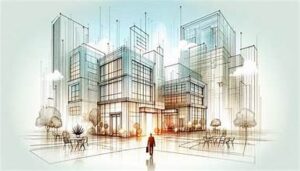As we step into 2024, the commercial real estate (CRE) landscape is undergoing significant transformations. These shifts are driven by a combination of technological advancements, changing economic conditions, and evolving consumer preferences. For investors, developers, and stakeholders, staying abreast of these trends is crucial for making informed decisions and capitalizing on emerging opportunities. Here’s an in-depth look at the top commercial real estate trends to watch in 2024, focusing on innovations and market shifts that are reshaping the future of this dynamic sector.
1. The Rise of Hybrid Workspaces
The pandemic has fundamentally changed how businesses operate, leading to the rise of hybrid work models. Companies are increasingly adopting flexible work arrangements, blending remote and in-office work. This shift is impacting the demand for office space, as businesses seek to optimize their real estate portfolios.
Key Points:
- Flexible Office Solutions: There is a growing demand for flexible office spaces that can accommodate varying team sizes and work styles. Co-working spaces and serviced offices are gaining traction as companies look for adaptable solutions.
- Redesigning Work Environments: Traditional office layouts are being reimagined to support collaboration and innovation while allowing for social distancing and health safety measures.
Implications: Investors and developers should consider the need for versatile office spaces and adaptive reuse of existing properties to meet the evolving needs of businesses.
2. Sustainability and Green Building Standards
Sustainability continues to be a significant focus in commercial real estate. As environmental concerns rise and regulations tighten, there is an increasing emphasis on green building practices and energy-efficient designs.
Key Points:
- LEED Certification: Properties with Leadership in Energy and Environmental Design (LEED) certification are becoming more attractive to tenants and investors. This certification signals a commitment to sustainability and can enhance a property’s marketability.
- Energy Efficiency: Innovations in energy-efficient technologies, such as smart HVAC systems and renewable energy sources, are becoming standard in new developments.
Implications: Incorporating sustainable practices can improve operational efficiency, reduce costs, and attract eco-conscious tenants, making it a worthwhile investment for developers and property managers.
3. Smart Buildings and IoT Integration
The integration of Internet of Things (IoT) technology is revolutionizing commercial real estate. Smart buildings equipped with advanced sensors and automation systems offer improved operational efficiency and enhanced tenant experiences.
Key Points:
- Building Management Systems (BMS): Modern BMS solutions enable real-time monitoring and control of building systems, such as lighting, heating, and cooling, leading to optimized energy use and reduced operational costs.
- Tenant Experience Apps: IoT-enabled apps are providing tenants with enhanced convenience and control over their environments, including features like automated lighting, climate control, and security.
Implications: Investing in smart building technologies can enhance property value, streamline operations, and offer a competitive edge in attracting and retaining tenants.
4. E-commerce and Industrial Space Expansion
The continued growth of e-commerce is driving demand for industrial and logistics spaces. As online shopping becomes more prevalent, companies require more extensive warehousing and distribution facilities.
Key Points:
- Last-Mile Delivery Centers: The rise of e-commerce has increased the need for last-mile delivery centers to ensure quick and efficient delivery to consumers.
- Warehouse Automation: Automation technologies, such as robotics and AI, are being integrated into warehouse operations to enhance efficiency and reduce labor costs.
Implications: Investors should consider the expanding demand for industrial spaces and the potential for growth in this sector, particularly in locations that are well-positioned for logistics and distribution.
5. Urban Redevelopment and Mixed-Use Projects
Urban redevelopment and mixed-use projects are gaining momentum as cities seek to revitalize aging infrastructure and create vibrant, multi-functional communities.
Key Points:
- Mixed-Use Developments: Combining residential, commercial, and retail spaces in a single development can create dynamic, walkable environments that attract residents and businesses alike.
- Adaptive Reuse: Converting existing buildings for new purposes, such as transforming old warehouses into loft apartments or office spaces, is a sustainable approach that preserves historical architecture while meeting modern needs.
Implications: Urban redevelopment and mixed-use projects offer opportunities for significant returns on investment and contribute to community revitalization efforts.
6. Health and Wellness Integration
Health and wellness are becoming integral components of commercial real estate design. Developers are increasingly focusing on creating environments that promote well-being and address health concerns.
Key Points:
- Healthy Building Certifications: Certifications such as WELL Building Standard (WELL) are becoming popular as they focus on factors like air quality, lighting, and acoustics to enhance occupant health.
- Amenities and Facilities: Properties featuring amenities such as fitness centers, green spaces, and wellness rooms are attracting tenants who prioritize health and well-being.
Implications: Incorporating health and wellness features into real estate projects can improve tenant satisfaction and attract a health-conscious demographic.
7. Artificial Intelligence and Data Analytics
Artificial intelligence (AI) and data analytics are transforming how commercial real estate is managed and marketed. These technologies provide valuable insights and enhance decision-making processes.
Key Points:
- Predictive Analytics: AI-driven predictive analytics can forecast market trends, tenant behavior, and property performance, allowing for more strategic planning and investment.
- Automated Valuation Models (AVMs): AVMs use AI to provide accurate property valuations based on various data points, streamlining the appraisal process.
Implications: Leveraging AI and data analytics can provide a competitive advantage, improve investment strategies, and optimize property management.
8. Global Economic Influences
Global economic factors, including inflation rates, interest rates, and geopolitical events, continue to impact the commercial real estate market. Staying informed about these influences is crucial for navigating market uncertainties.
Key Points:
- Interest Rate Fluctuations: Changes in interest rates can affect financing costs and investment returns, influencing investment decisions and property valuations.
- Geopolitical Risks: Geopolitical events, such as trade disputes and political instability, can impact market conditions and investor confidence.
Implications: Monitoring global economic trends and adjusting strategies accordingly can help mitigate risks and capitalize on emerging opportunities.
9. Enhanced Regulatory Compliance
Regulatory changes and increased scrutiny are shaping the commercial real estate sector. Compliance with evolving regulations is essential for avoiding legal issues and ensuring sustainable practices.
Key Points:
- Zoning and Land Use Regulations: Changes in zoning laws and land use regulations can impact development opportunities and property values.
- Environmental Regulations: Stricter environmental regulations are pushing developers to adopt green building practices and reduce their environmental footprint.
Implications: Staying abreast of regulatory changes and ensuring compliance can prevent legal challenges and contribute to long-term success.
10. Rise of Alternative Investments
Alternative investments, such as real estate investment trusts (REITs) and crowdfunding platforms, are becoming more popular in the commercial real estate sector. These investment vehicles offer diversified options for investors.
Key Points:
- REITs: REITs provide an opportunity to invest in a diversified portfolio of real estate assets without directly owning properties, offering liquidity and income potential.
- Crowdfunding: Real estate crowdfunding platforms allow investors to participate in projects with lower capital requirements, broadening access to investment opportunities.
Implications: Exploring alternative investment options can provide new avenues for capital deployment and portfolio diversification.
Conclusion
As we navigate through 2024, the commercial real estate sector is evolving in response to technological advancements, changing market dynamics, and shifting consumer preferences. From hybrid workspaces and sustainability to smart buildings and e-commerce expansion, these trends are shaping the future of commercial real estate. By staying informed and adapting to these changes, investors, developers, and stakeholders can position themselves for success in a rapidly changing landscape.





